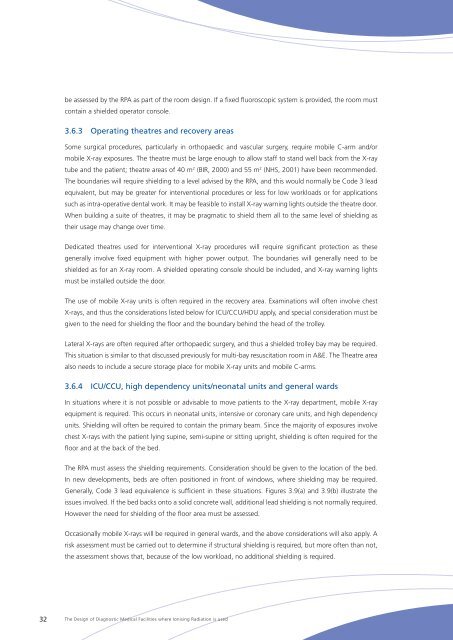The Design of Diagnostic Medical Facilities where ... - ResearchGate
The Design of Diagnostic Medical Facilities where ... - ResearchGate
The Design of Diagnostic Medical Facilities where ... - ResearchGate
Create successful ePaper yourself
Turn your PDF publications into a flip-book with our unique Google optimized e-Paper software.
e assessed by the RPA as part <strong>of</strong> the room design. If a fixed fluoroscopic system is provided, the room must<br />
contain a shielded operator console.<br />
3.6.3 Operating theatres and recovery areas<br />
Some surgical procedures, particularly in orthopaedic and vascular surgery, require mobile C-arm and/or<br />
mobile X‐ray exposures. <strong>The</strong> theatre must be large enough to allow staff to stand well back from the X‐ray<br />
tube and the patient; theatre areas <strong>of</strong> 40 m 2 (BIR, 2000) and 55 m 2 (NHS, 2001) have been recommended.<br />
<strong>The</strong> boundaries will require shielding to a level advised by the RPA, and this would normally be Code 3 lead<br />
equivalent, but may be greater for interventional procedures or less for low workloads or for applications<br />
such as intra-operative dental work. It may be feasible to install X‐ray warning lights outside the theatre door.<br />
When building a suite <strong>of</strong> theatres, it may be pragmatic to shield them all to the same level <strong>of</strong> shielding as<br />
their usage may change over time.<br />
Dedicated theatres used for interventional X‐ray procedures will require significant protection as these<br />
generally involve fixed equipment with higher power output. <strong>The</strong> boundaries will generally need to be<br />
shielded as for an X‐ray room. A shielded operating console should be included, and X‐ray warning lights<br />
must be installed outside the door.<br />
<strong>The</strong> use <strong>of</strong> mobile X‐ray units is <strong>of</strong>ten required in the recovery area. Examinations will <strong>of</strong>ten involve chest<br />
X‐rays, and thus the considerations listed below for ICU/CCU/HDU apply, and special consideration must be<br />
given to the need for shielding the floor and the boundary behind the head <strong>of</strong> the trolley.<br />
Lateral X‐rays are <strong>of</strong>ten required after orthopaedic surgery, and thus a shielded trolley bay may be required.<br />
This situation is similar to that discussed previously for multi-bay resuscitation room in A&E. <strong>The</strong> <strong>The</strong>atre area<br />
also needs to include a secure storage place for mobile X‐ray units and mobile C-arms.<br />
3.6.4 ICU/CCU, high dependency units/neonatal units and general wards<br />
In situations <strong>where</strong> it is not possible or advisable to move patients to the X‐ray department, mobile X‐ray<br />
equipment is required. This occurs in neonatal units, intensive or coronary care units, and high dependency<br />
units. Shielding will <strong>of</strong>ten be required to contain the primary beam. Since the majority <strong>of</strong> exposures involve<br />
chest X‐rays with the patient lying supine, semi-supine or sitting upright, shielding is <strong>of</strong>ten required for the<br />
floor and at the back <strong>of</strong> the bed.<br />
<strong>The</strong> RPA must assess the shielding requirements. Consideration should be given to the location <strong>of</strong> the bed.<br />
In new developments, beds are <strong>of</strong>ten positioned in front <strong>of</strong> windows, <strong>where</strong> shielding may be required.<br />
Generally, Code 3 lead equivalence is sufficient in these situations. Figures 3.9(a) and 3.9(b) illustrate the<br />
issues involved. If the bed backs onto a solid concrete wall, additional lead shielding is not normally required.<br />
However the need for shielding <strong>of</strong> the floor area must be assessed.<br />
Occasionally mobile X‐rays will be required in general wards, and the above considerations will also apply. A<br />
risk assessment must be carried out to determine if structural shielding is required, but more <strong>of</strong>ten than not,<br />
the assessment shows that, because <strong>of</strong> the low workload, no additional shielding is required.<br />
32<br />
<strong>The</strong> <strong>Design</strong> <strong>of</strong> <strong>Diagnostic</strong> <strong>Medical</strong> <strong>Facilities</strong> <strong>where</strong> Ionising Radiation is used
















